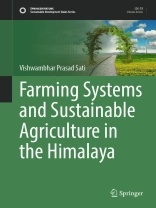The farming system in the Central Himalayan Region is distinctive and unique, mainly focusing on the cultivation of traditional subsistence cereal crops. The agrobiodiversity in this region is rich, with the Central Himalaya growing numerous cultivars and crop races. The practice of cultivating many crops or cultivars in a single field is known as the ‘Barahnaja System.’ Another peculiar system is the Sar/Sari system, where different crops grow in the two Sars during the same seasons, with one Sar left fallow for six months while the other grows crops. This century-old farming method involves plowing fields with oxen and using organic manure to enhance crop production and productivity. However, recent changes have been observed in the farming systems. The area under traditionally growing millets is declining. In river valleys and middle altitudes, there is a recent trend towards cultivating paddy and wheat. Unfortunately, the cultivation of temperate fruits – apple and citrus has seen a decline in terms of area, production, and productivity. Various factors are influ encing farming systems in the Central Himalaya, such as high climate variability and change, decreasing crop production and productivity, evolving food habits, and out-migration. The book contains 12 chapters illustrating introduction, land use and land cover change, cropping patterns, crop diversity and agro-ecological zones, farming systems and sustainable agriculture, climate change and its impact on agriculture, infrastructural facilities for sustainable agriculture, declining agriculture: a case study, crop productivity and suitability analyzes, agribusiness, policies and planning for sustainable agriculture, and conclusions. It serves as a valuable resource for students, academicians, researchers, policymakers, and farmers.
สารบัญ
Introduction.- Land Use Patterns and Land Cover Change.- Cropping Patterns and Change.- Crop Diversity and Agro-climatic Zones.- Farming Systems and Sustainable Agriculture.- Climate Change and its Impact on Agriculture.- Infrastructural Facilities for Sustainable Agriculture.- Declining Agriculture: A Case Study.- Crop Productivity and Suitability Analysis.- Role of Agribusiness in Sustainable Rural Livelihood.- Policies and Planning for Sustainable Agriculture.- Conclusions.
เกี่ยวกับผู้แต่ง
Vishwambhar Prasad Sati, born in 1966, holds a Doctor of Letters (D.Litt.) and Ph.D. degrees, currently serving as a Senior Professor of Geography and Resource Management at Mizoram University, a Central University in Aizawl, India. With nearly three decades of teaching experience, he has contributed to various higher education institutions within and outside India, including the Eritrea Institute of Technology in Asmara, Eritrea (NE Africa), the Institute of Mountain Hazards and Environment in Chengdu, China, and HNB Garhwal University in Srinagar Garhwal. Throughout his illustrious career, he has actively engaged in research, holding positions as a Visiting Professor and Visiting Scholar at esteemed institutions such as The World Academy of Sciences, the Chinese Academy of Sciences, the Indian National Science Academy, the Indian Council of Social Science Research, and the Indian Institute of Advanced Studies. He has received recognition for his contributions, including a Visiting Professor Award from the Ministry of Education and Science at Lviv Polytechnic National University in Lviv, Ukraine and Impact Policy Research Institute, New Delhi, India, a best paper award from Natural Hazards Research (an Elsevier Journal), best presentation award in the International Conference, held at Jurich, Switzerland, best 20 influential academicians in India, and the title of Senior Global Fellow from the Grassroots Institute in Canada. His extensive travels, spanning 45 countries and all over India, have contributed to his comprehensive understanding of diverse geographical landscapes. Additionally, he has successfully supervised a dozen Ph.D. scholars. His expertise lies in Natural Resource Management, Environment-Development Interface, Climate Change, Rural Livelihoods, Disaster-Related issues, and the Culture of the Himalayan region. He has developed numerous models and action plans for environmental conservation and economic development in the fragile Himalayan ecosystems. His impactful contributions extend to more than 200 research papers and articles and over three dozen published books, establishing his academic legacy at both national and international levels.












